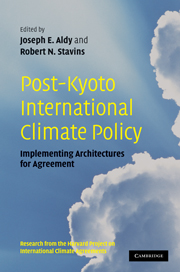Book contents
- Frontmatter
- Contents
- Harvard Environmental Economics Program, International Advisory Board
- Harvard Project on International Climate Agreements, Faculty Steering Committee
- Harvard Project on International Climate Agreements, Project Management
- List of figures
- List of tables
- List of contributors
- Foreword
- 1 Introduction
- Part I Alternative international policy architectures
- Part II Negotiation, assessment, and compliance
- Part III The role and means of technology transfer
- Part IV Global climate policy and international trade
- Part V Economic development, adaptation, and deforestation
- 18 Reconciling human development and climate protection: a multistage hybrid climate policy architecture
- 19 What do we expect from an international climate agreement? A perspective from a low-income country
- 20 Climate accession deals: new strategies for taming growth of greenhouse gases in developing countries
- 21 Policies for developing country engagement
- 22 International forest carbon sequestration in a post-Kyoto agreement
- Part VI Modeling impacts of alternative allocations of responsibility
- Part VII Synthesis and conclusion
- Appendix A Selected List of Individuals Consulted, Harvard Project on International Climate Agreements
- Appendix B Workshops and Conferences, Harvard Project on International Climate Agreements
- Glossary and Abbreviations
- Index
19 - What do we expect from an international climate agreement? A perspective from a low-income country
Published online by Cambridge University Press: 05 June 2012
- Frontmatter
- Contents
- Harvard Environmental Economics Program, International Advisory Board
- Harvard Project on International Climate Agreements, Faculty Steering Committee
- Harvard Project on International Climate Agreements, Project Management
- List of figures
- List of tables
- List of contributors
- Foreword
- 1 Introduction
- Part I Alternative international policy architectures
- Part II Negotiation, assessment, and compliance
- Part III The role and means of technology transfer
- Part IV Global climate policy and international trade
- Part V Economic development, adaptation, and deforestation
- 18 Reconciling human development and climate protection: a multistage hybrid climate policy architecture
- 19 What do we expect from an international climate agreement? A perspective from a low-income country
- 20 Climate accession deals: new strategies for taming growth of greenhouse gases in developing countries
- 21 Policies for developing country engagement
- 22 International forest carbon sequestration in a post-Kyoto agreement
- Part VI Modeling impacts of alternative allocations of responsibility
- Part VII Synthesis and conclusion
- Appendix A Selected List of Individuals Consulted, Harvard Project on International Climate Agreements
- Appendix B Workshops and Conferences, Harvard Project on International Climate Agreements
- Glossary and Abbreviations
- Index
Summary
The non-marginal nature of the climate problem and the importance of technological change
Allowing Earth's global mean temperature to rise by more than 1–2 degrees Celsius above its current level carries significant risk of triggering positive feedbacks that further raise temperature and lead to catastrophic climatic changes (Hansen, Sato et al. 2006; Lenton, Held et al. 2008). To limit warming to such a small rise in temperature, when current greenhouse gas (GHG) concentrations already commit us to an increase of 0.3–0.9 degrees Celsius above a reference level equal to global average temperatures over the period 1980–1999 (IPCC 2007a), will require massive cuts in carbon dioxide (CO2) emissions by the middle of the century. The climate problem cannot be tackled by tinkering at the margins.
Eliminating CO2 emissions is difficult for the simple reason that it is cheaper to obtain energy by burning coal, oil, and gas than by harnessing the sun, the wind, or atomic nuclei. The 2007 report of the Intergovernmental Panel on Climate Change reviewed the scientific literature and concluded that there are currently available, low-cost or even profitable opportunities for reducing CO2 emissions, mainly through the installation of energy-conserving equipment and techniques in industry, building, and transport. However, tapping low-cost reduction opportunities can achieve at most a cut of a few percentage points below business-as-usual (BAU) emissions (IPCC 2007). With current technologies, deeper cuts can come only by raising the cost of energy.
- Type
- Chapter
- Information
- Post-Kyoto International Climate PolicyImplementing Architectures for Agreement, pp. 599 - 617Publisher: Cambridge University PressPrint publication year: 2009
- 6
- Cited by

